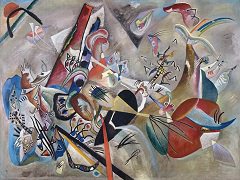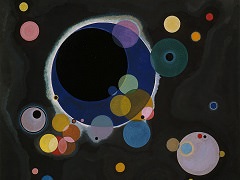Composition IX, 1936 by Wassily Kandinsky

Kandinsky, considered his 'Compositions' to be the most resolved of all his paintings, beginning with the first of them that he painted in Munich. This, his penultimate 'Composition', is perhaps the most striking and the most resolved all, a perfect synthesis of intuition and construction, a union of the artist's head and heart. The brood bands of luscious exotic colours are separated by the black band that seems to blend amorphously with the other bands at the top of the picture, providing a structured and well-balanced ground for the other forms. The three bonds of blue and black that cross it provide a Theosophical tension, redolent of Piet Mondrian's paintings that depict the competing forces of the material and spiritual worlds.
Although most of the forms are amorphous, they are regulated and balanced by the recognizable geometrical shapes of the circle and rectangle. As he said in his essay 'Two Currents', written in 1935, 'A work's structure is not dictated by fragments of nature but by the totality of natural laws governing the cosmos.'
















